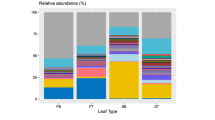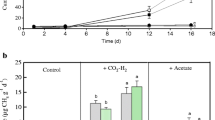Abstract
Wetlands are the largest natural sources of methane, and many wetlands are subject to nutrient enrichment due to runoff from adjacent agricultural and urban lands. Methanogenic archaea are responsible for much of the methane produced in terrestrial wetlands and participate in a range of additional activities including nitrogen fixation and mercury methylation. Nutrient enrichment may impact the dominant metabolic groups of methanogens, such that the fundamental activities of methanogens may be associated with the nutrient status of the wetland. Regions of the Everglades, a large marsh in the southern part of Florida, in the USA, are subject to nutrient enrichment and are characterized by a gradient in available phosphorus, organic carbon, and sulfate concentrations. This marsh provides an outstanding system in which to study the impacts of nutrient enrichment on the distribution and activities of methanogens. Competition for acetate with sulfate-reducing prokaryotes plays an important role in structuring methanogenic consortia in nutrient-impacted regions, and the potentials for methanogenic nitrogen fixation and mercury methylation differ along the nutrient gradient.
Access this chapter
Tax calculation will be finalised at checkout
Purchases are for personal use only
Similar content being viewed by others
References
Anderson JAR (1964) The structure and development of peat swamps of Sarawak and Brunei. J Trop Geogr 18:7–16
Bae HS, Holmes ME, Chanton JP et al (2015) Distribution, activities, and interactions of methanogens and sulfate-reducing prokaryotes in the Florida Everglades. Appl Environ Microbiol 81:7431–7442
Bae HS, Morrison E, Chanton JP, Ogram A (2018) Methanogens are major contributors to nitrogen fixation in soils of the Florida Everglades. Appl Environ Microbiol:e02222-17
Bae HS, Dierberg FE, Ogram A (2014) Syntrophs dominate sequences associated with the mercury methylation-related gene hgcA in the water conservation areas of the Florida Everglades. Appl Env Microbiol 20:6517–6526
Belay N, Sparling R, Daniels L (1984) Dinitrogen fixation by a thermophilic methanogenic bacterium. Nature 312:286–288
Borrel G, O’Toole PW, Harris HM et al (2013) Phylogenomic data support a seventh order of methylotrophic methanogens and provide insights into the evolution of methanogenesis. Genome Biol Evol 5:1769–1780
Castro HF, Newman S, Reddy KR, Ogram A (2005) Distribution and stability of sulfate reducing prokaryotic and hydrogenotrophic methanogenic assemblages in nutrient-impacted regions of the Florida Everglades. Appl Environ Microbiol 71:2695–2704
Castro HF, Ogram A, Reddy KR (2004) Phylogenetic characterization of methanogenic assemblages in eutrophic and oligotrophic areas of the Florida Everglades. Appl Environ Microbiol 70:6559–6568
Castro HF, Williams N, Ogram A (2000) Phylogeny of sulfate reducing bacteria. FEMS Microbiol Ecol 31:1–9
Chauhan A, Ogram A (2006) Stable isotope probing of fatty acid oxidizing guilds in the Florida Everglades. Appl Environ Microbiol 72:2400–2406
Chauhan A, Ogram A, Reddy KR (2004) Syntrophic-methanogenic associations along a nutrient gradient in the Florida Everglades. Appl Environ Microbiol 70:3475–3484
Conrad R (1999) Contribution of hydrogen to methane production and control of hydrogen concentrations in methanogenic soils and sediments. FEMS Microbiol Ecol 28:193–202
Corstanje R, Reddy KR, Prenger J et al (2007) Soil microbial eco-physiological response to nutrient enrichment in a sub-tropical wetland. Ecol Indic 7:277–289
de Bok FA, Stams A, Dijkema C, Boone DR (2001) Pathway of propionate oxidation by a syntrophic culture of Smithella propionica and Methanospirillum hungatei. Appl Environ Microbiol 67:1800–1804
Frederick P, Jayasena N (2011) Altered pairing behavior and reproductive success in white ibises exposed to environmentally relevant concentrations of methylmercury. Proc R Soc B 278:1851–1857
Freeman C, Ostle N, Kang H (2001) An enzymic latch on a global carbon store. Nature 409:149
Gilmour CC, Podar M, Bullock AL et al (2013) Mercury methylation by novel microorganisms from new environments. Environ Sci Technol 47:11810–11820
Gilmour CC, Riedel GS, Ederington MC et al (1998) Methylmercury concentrations and production rates across a trophic gradient in the northern Everglades. Biogeochemistry 40:327–345
Hamelin S, Amyot M, Barkay T et al (2011) Methanogens: principal methylators of mercury in lake periphyton. Environ Sci Technol 45:7693–7700
Harmsen HJM, van Kuijk BLM, Plugge CM et al (1998) Syntrophobacter fumaroxidans sp. nov., a syntrophic propionate-degrading sulfate reducing bacterium. Int J Syst Bacteriol 48:1383–1387
Holmes BE, Chanton J, Bae HS, Ogram A (2014) Effect of nutrient enrichment on δ13C and the methane production pathway in the Florida Everglades. J Geophys Res 118:1–11
Inglett P, Rivera-Monroy V, Wozniak J (2011) Biogeochemistry of nitrogen across the Everglades landscape. Crit Rev Env Sci Technol 41:187–216
Liu Y, Balkwill D, Aldrich H et al (1999) Characterization of the anaerobic propionate-degrading syntrophs Smithella propionica gen. nov., sp. nov. and Syntrophobacter wolinii. Int J Syst Bacteriol 49:545–556
Lovley DR, Dwyer DF, Klug MJ (1982) Kinetic analysis of competition between sulfate reducers and methanogens for hydrogen in sediments. Appl Environ Microbiol 43:1373–1379
McInerney MJ, Struchtemeyer CG, Sieber J et al (2008) Physiology, ecology, phylogeny, and genomics of microorganisms capable of syntrophic metabolism. Ann N Y Acad Sci 1125:58–72
Morris BE, Henneberger R, Huber H, Moissl-Eichinger C (2013) Microbial syntrophy: interaction for the common good. FEMS Microbiol Rev 37:384–406
Morrison E, Newman S, Bae HS et al (2016) Microbial genetic and enzymatic responses to an anthropogenic phosphorus gradient within a subtropical peatland. Geoderma 268:119–127
Murray PA, Zinder SH (1984) Nitrogen fixation by a methanogenic archaebacterium. Nature 312:284–286
Nüsslein B, Eckert W, Conrad R (2003) Stable isotope biogeochemistry of methane formation in profundal sediments of Lake Kinneret (Israel). Limnol Oceanogr 48:1439–1446
Nüsslein B, Chin KJ, Eckert W, Conrad R (2001) Evidence for anaerobic syntrophic acetate oxidation during methane production in the profundal sediment of Lake Kinneret (Israel). Environ Microbiol 3:460–470
Parks JM, Johs A, Podar M et al (2013) The genetic basis for bacterial mercury methylation. Science 339:1332–1335
Penton CR, Newman S (2007) Enzyme activity responses to nutrient loading in subtropical wetlands. Biogeochemistry 84:83–98
Prakash O, Pandey PK, Kulkami GJ et al (2014) Technicalities and glitches of terminal restriction fragment length polymorphism (T-RFLP). Indian J Microbiol 54:255–261
Robinson J, Tiedje J (1984) Competition between sulfate-reducing and methanogenic bacteria for H2 under resting and growing conditions. Arch Microbiol 137:26–32
Schink B (1997) Energetics of syntrophic cooperation in methanogenic degradation. Microbiol Mol Biol Rev 61:262–280
Schönheit P, Kristjansson JK, Thauer RK (1982) Kinetic mechanism for the ability of sulfate reducers to out-compete methanogens for acetate. Arch Microbiol 132:285–288
Uz I, Ogram A (2006) Cellulolytic and fermentative guilds in the Florida Everglades. FEMS Microbiol Ecol 57:396–408
van Amstel A (2012) Methane. A review. Integr Environ Sci 9:5–30
Voolapalli RK, Stuckey DC (1999) Relative importance of trophic group concentrations during anaerobic degradation of volatile fatty acids. Appl Environ Microbiol 65:5009–5016
Wallrabenstein C, Hauschild E, Schink B (1995) Syntrophobacter pfennigii sp. nov., a new syntrophically propionate-oxidizing anaerobe growing in pure culture with propionate and sulfate. Arch Microbiol 164:346–352
White JR, Reddy KR (2003) Nitrification and denitrification rates of Everglades wetland soils along a phosphorus-impacted gradient. J Environ Qual 32:2436–2443
Author information
Authors and Affiliations
Corresponding author
Editor information
Editors and Affiliations
Ethics declarations
Conflict of Interest
Andrew Ogram declares that he has no conflicts of interest. Hee-Sung Bae declares that he/she has no conflicts of interest. Ashvini Chauhan declares that he/she has no conflicts of interest.
Ethical Approval
This article does not contain any studies with human participants or animals performed by any of the authors.
Rights and permissions
Copyright information
© 2019 Springer Nature Switzerland AG
About this chapter
Cite this chapter
Ogram, A., Bae, HS., Chauhan, A. (2019). The Ecology of Methanogenic Archaea in a Nutrient-Impacted Wetland. In: Hurst, C. (eds) The Structure and Function of Aquatic Microbial Communities. Advances in Environmental Microbiology, vol 7. Springer, Cham. https://doi.org/10.1007/978-3-030-16775-2_6
Download citation
DOI: https://doi.org/10.1007/978-3-030-16775-2_6
Published:
Publisher Name: Springer, Cham
Print ISBN: 978-3-030-16773-8
Online ISBN: 978-3-030-16775-2
eBook Packages: Biomedical and Life SciencesBiomedical and Life Sciences (R0)




